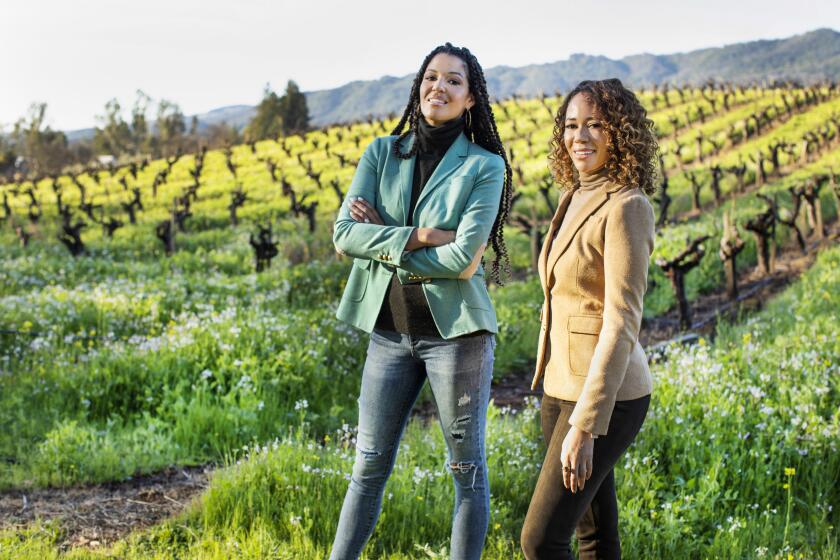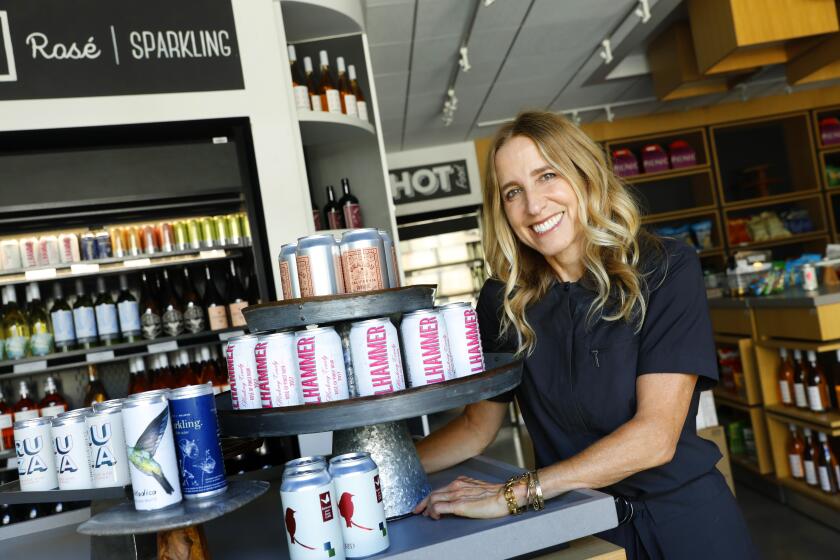Check the attitude. There are more reasons than ever to try canned wines
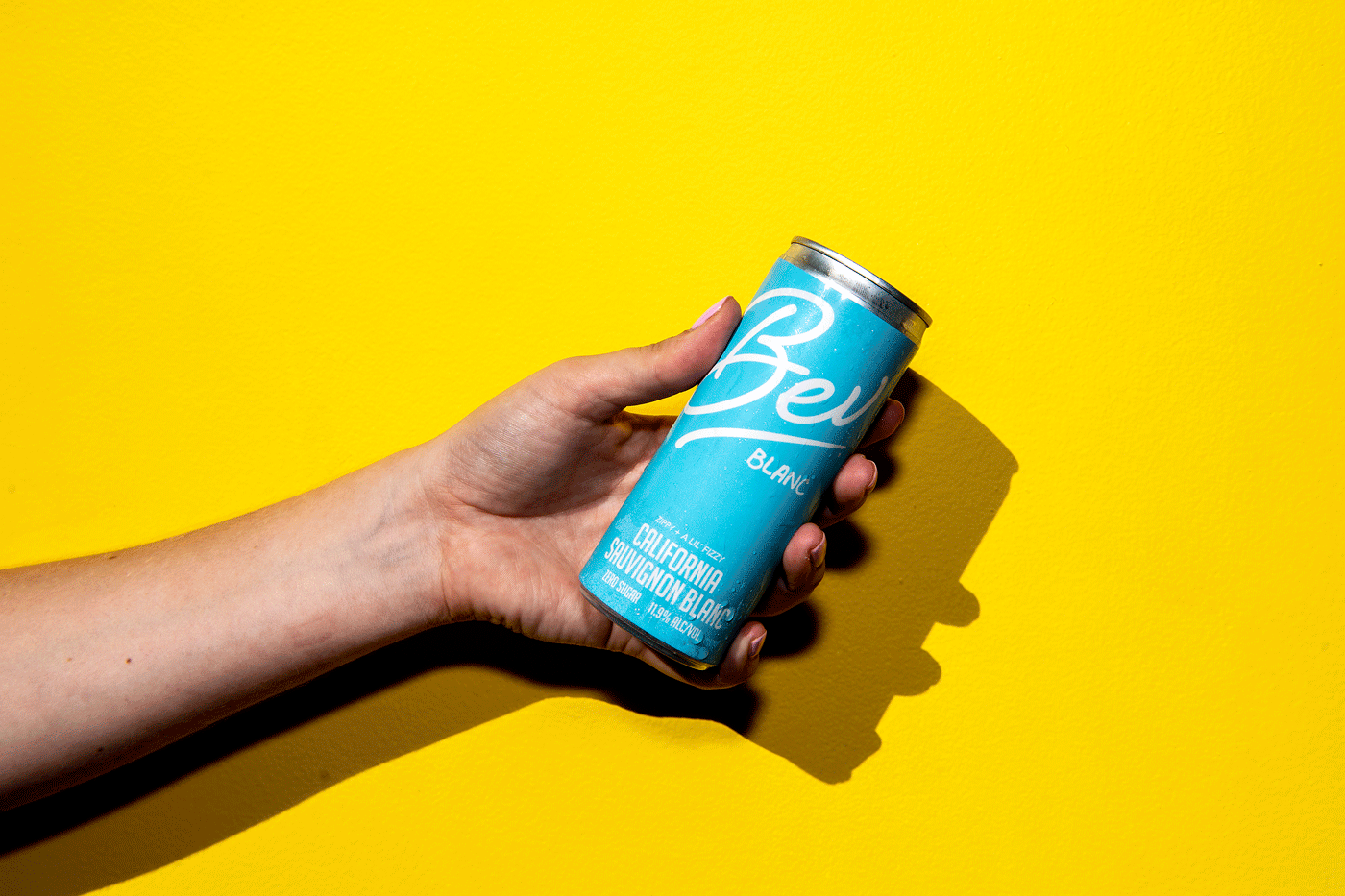
- Share via
Canned wines have been encroaching on liquor and grocery store shelves for years — at a snail’s pace. But the pandemic, all the restrictions that came with it and the resulting increase in online shopping changed that — there’s been a surge in the popularity of canned wines. Today even cork-sniffing, glass-swirling wine lovers may be tempted to give them a try.
Industry experts know there’s a lot to talk about. Danelle Kosmal, senior vice president of NielsenIQ Beverage Alcohol Practice, which tracks off-premise sales of alcoholic beverages, says increased sales of canned wines “tell me it’s not just a fad, it’s a trend.”
Today, Kosmal said, “There are more than three times more canned-wine brands within the NielsenIQ database than in 2017 — about 235 today to 68 back then. At the start of the pandemic, canned wine accounted for 0.7% of those wine sales. The segment’s share has increased to 1.2% of wine dollars this summer.” Looking at the past two years, she said, sales have doubled.
Kosmal points to three factors fueling the increase. The first is obvious: the portability of cans, making them ideal for outdoor consumption. The second is perhaps more illusory.
“Many of the sparkling canned wines are actually wine spritzers, with soda water added to make them bubbly as well as less alcoholic and less caloric,” she said. “Add that to the ease of portion control with canned wines, and consumers perceive them as better for their health and wellness.”
The third factor? The popularity of canned wine among younger consumers. “Drinkers ages 21 to 34 represent only 15% of bottled wine buyers but 26% of canned wine buyers and 29% of canned sparkling wine buyers,” Kosmal said.
Caroline Styne, co-owner and wine director of the Lucques Group of restaurants and wine director of Hollywood Bowl Food & Wine, has witnessed the new interest in canned wines. “Our first year at the Bowl, in 2016, I was, ‘Canned wine? What?’ But by the second year I realized some really good winemakers were putting super-solid wine in cans,” she said. “I thought, ‘Why not give people options?’”
The options are growing.
::
In 2018 Alix Peabody, then 26 and an MFA student in screenwriting at USC, launched Bev canned wine company to pay off extensive medical bills. “I started with cans because it’s hard to create brand recognition around a bottled product,” she said. “Once you pour it into a glass, no one can tell what you’re drinking, but cans are essentially mini-billboards for the brand.”
With its vibrantly hued mini-cans of 100-calorie, zero-sugar, low-carb wine spritzers, Bev (which is based in Venice) is aimed at women. Peabody says the brand’s online presence has been crucial. “When lockdown hit, we had to get creative in order to reach our consumers at home,” she said. “We built a text-to-order platform in 48 hours, launched a new website designed for increased conversion and started running ads.”
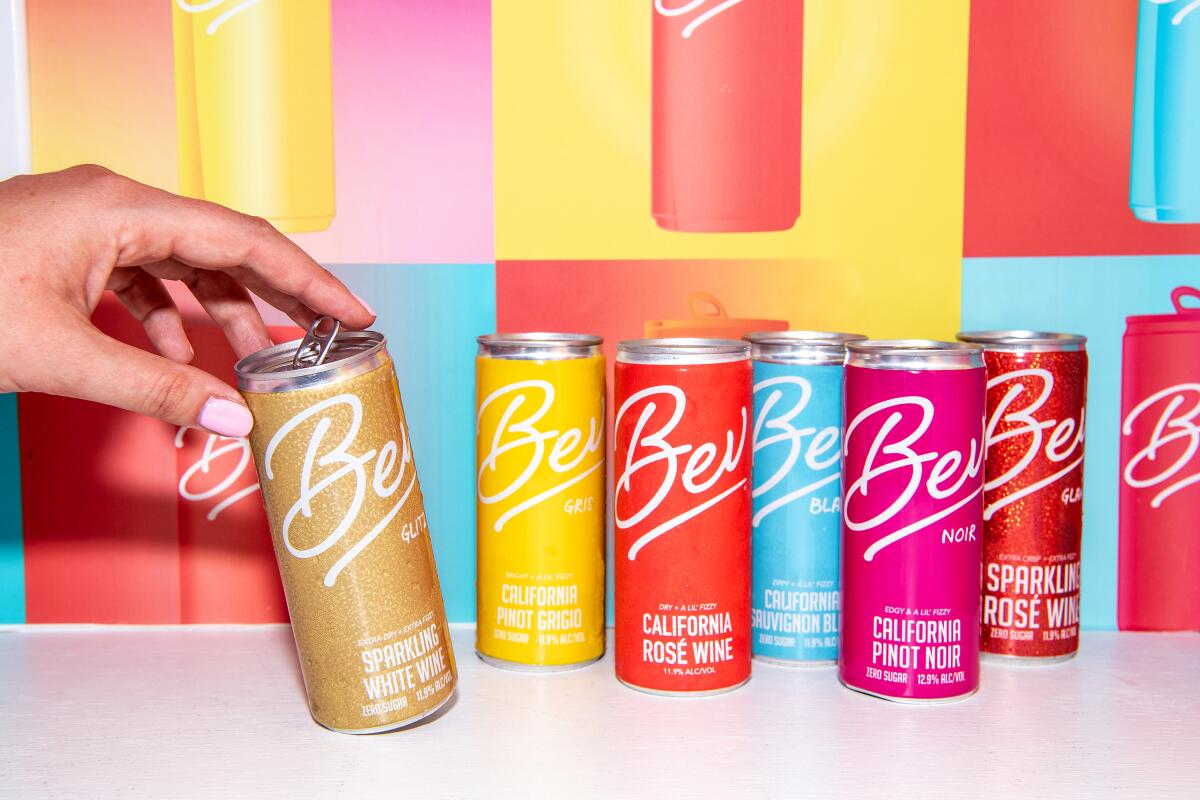
Peabody aligned with charitable causes to help build community. “We set up an L.A. Service Workers Relief Fund and for one month donated 100% of our online sales to it,” she said. “We also encouraged the Bev community to donate to the initiative’s GoFundMe and matched the first $3,000 of donations. Bev’s sales grew 200% month over month during the pandemic.”
Earlier this year Peabody signed a deal with E. & J. Gallo, the largest family-owned winery in the U.S., to distribute Bev nationally in supermarkets, Target, BevMo and other stores. “Traditionally men buy wine in liquor stores while women buy wine in grocery stores,” she said. “Gallo is putting Bev at women’s fingertips.” According to Olivier Kielwasser, the category lead for wine at BevMo, Bev Gris Pinot Grigio is now the store’s top-selling canned white wine.
Comedian Josh Ostrovsky, whose @thefatjewish Instagram account has 10.2 million followers, launched BABE Rosé With Bubbles wine in 250-milliliter cans in 2016 with partners David and Tanner Cohen. In 2018, Anheuser-Busch bought a minority stake in the company; it acquired BABE outright the following year. “From July 2020 to July 2021, the canned wine category grew more than 32% in dollar sales — and Babe grew three times faster,” said Chelsea Phillips, general manager of BABE.
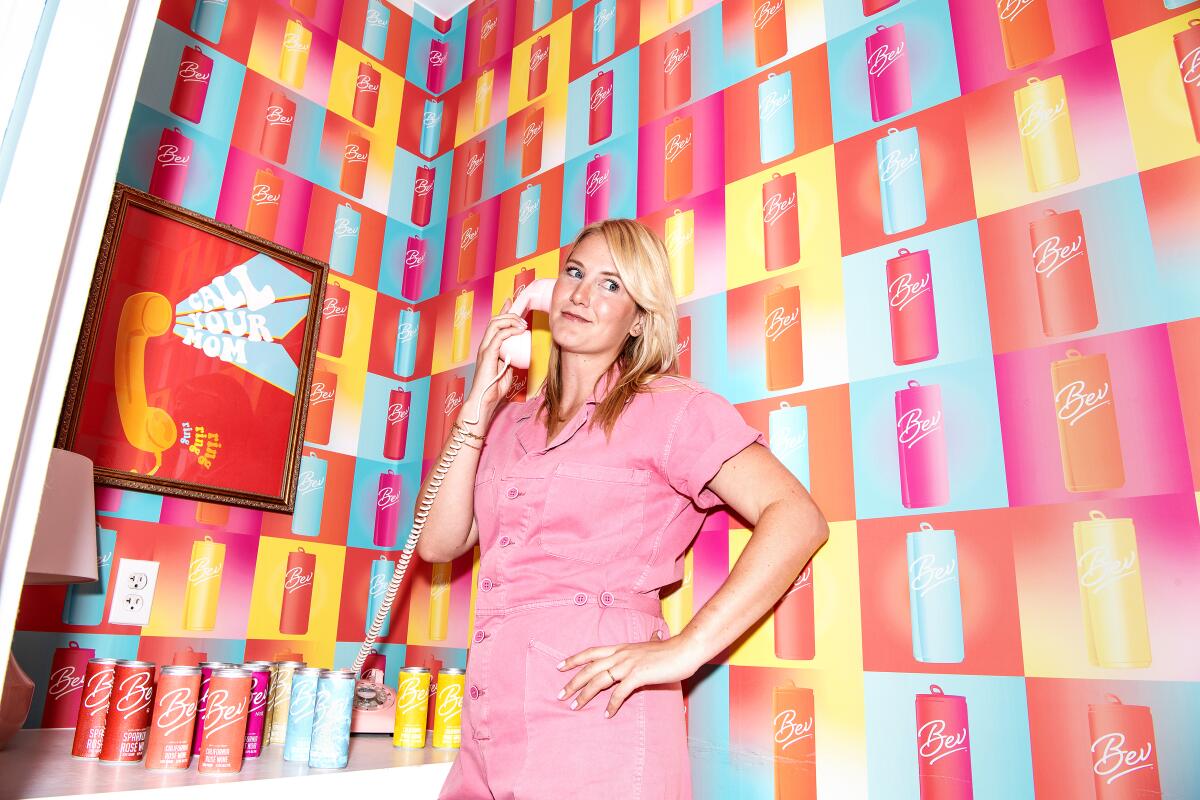
With behemoth alcohol companies like Gallo and Anheuser-Busch diving into the canned-wine business, it’s no surprise some premium winemakers have joined in. One of them is Doug Margerum, whose hand-crafted Margerum and Barden Santa Barbara wines are priced from $25 to $60 a bottle. Between 2008 and 2012, Margerum learned the Provençal way of making rosé in France. His resulting vintage California Riviera Rosé debuted in bottles in 2012. In 2020 he introduced it in 375-milliliter cans as well.
“We were looking for a greener alternative to bottles and liked how the can keeps wine fresh and bright,” he said. “Rosé is a natural in a can because it’s meant to be enjoyed chilled.” Margerum says he has barely been able to keep up with demand.
“We are in a unique niche because most canned wine is commodity wine and we are a premium producer,” he said. “Our audience has been clubs with pools, yacht charters, restaurants with patios — places where premium wine is desired but the weight of bottles and possible glass breakage is not.”
Emmanuel Kemiji is one of only 269 master sommeliers in the world — and the first to make wine in a can. He launched L+i canned wines in 2020. “Several years ago, I started to see canned wines pop up in stores, but I was too set in traditional ways to take them seriously, plus some were covered with cartoonish labels that hardly lend one to think there’s quality wine within the can,” he said. “Then I realized cans get cold quicker, are lighter and have a lower carbon footprint than bottles, plus they preserve wine quite well.”
Robin and Andréa McBride are co-founders of McBride Sisters Collection, the largest Black-owned wine company in the U.S.
As a winemaker, Kemiji has won awards for his premium Miura Vineyards Sonoma wines and Clos Pissarra Spanish wines. “I bottle my vintage wines because bottles have an advantage for long-term aging,” he said. “But I realized that 97% of all wine purchased today is consumed within three days of buying it. That’s why I launched L+i wine in cans.”
The line includes 250-milliliter cans of Pinot Grigio, Chardonnay, rosé of Pinot Noir and red blend the Bloc. Now the company is selling about 2,500 cases a quarter and growing rapidly as distribution expands nationally. “We saw a 100% increase in sales during the first two quarters this year compared to the first two quarters last year,” said Kemiji. “Our canned wines are selling twice as fast as our bottled wines.”
Some makers of natural wines are putting them in cans. “We feel the can is a more stable environment for natural wines,” said Jake Stover, co-founder and winemaker of Sans Wine Co. in Napa Valley. Sans makes a variety of natural, organic, unsulfured, single-vineyard, vintage-specific wines in 375-milliliter cans. “With cans there is no UV light penetration or oxygen exchange, and aluminum cans hold temperature better than glass bottles. Cans allow our wines to have a longer shelf life.”
Sans produced 9,000 cases in 2020, double its first 2016 vintage, and is on track to double production again this year. One of Sans’ canned wines, Carbonic Carignan, a red made without oak aging in a 100% whole-cluster carbonic fermentation, has been so popular that it’s now being sold in bottles as well. “Our customers requested it in bottles for the dinner table,” said co-founder and CEO Gina Schober.
::
The wine industry was thinking about cans decades ago. After the end of Prohibition in 1933, brewers started selling beer in steel cans. Canned beer was an immediate success, so some California wineries started selling canned muscatel, port and sherry. The high acidity and high (20%) alcohol content of these fortified wines ate away at the protective can lining, causing spoilage. Sporadic attempts to sell wine in aluminum cans starting in the 1960s were met with minimal success, not just because of iffy wine quality but because of public indifference. In the 1990s, improvements to the can lining solved the first problem but not the second.
Oscar-winning film director and winery founder Francis Ford Coppola often is credited with jump-starting the current canned wine trend. “Francis wanted to push the limits of the wine category and its traditional bottled offerings,” said Corey Beck, director of winemaking at Francis Ford Coppola Winery. “He aimed to attract a new, younger consumer with packaging that took the intimidation out of wine.”
Styne is the co-owner and wine director of the Lucques Group of restaurants and is the wine director of Hollywood Bowl Food & Wine.
In 2004, Coppola Family Wines launched a canned version of Sofia Blanc de Blancs, its bottled sparkling wine named for Francis’ daughter, director Sofia Coppola. The diminutive, shiny rose-pink 187-milliliter cans, each with an attached mini straw, were packaged in eye-catching rosé-pink octagonal four-packs. They sold out immediately. Sofia Brut Rosé in mini-cans followed in 2018 and Sofia Rosé in 2019. The Sofia canned wines were so successful, today Coppola Winery sells its bottled Diamond Collection wines in 250-milliliter cans as well, and in June it launched Pool House, a new brand of low-calorie, low-alcohol wines in bottles and 375-milliliter cans.
After the debut of the first Sofia in cans, other wineries entered the canned wine space. One was Union Wine Company, founded in 2005 by Ryan Harms and today the largest winery in Oregon. “Our staff would share stories about their weekend adventures — camping, hiking, river rafting,” said Union Wine Company marketing director Darin Dougherty. “Ryan noticed beer was typically a part of those experiences but not wine. He figured if we put some of our wine in cans similar in size to beer cans, not tiny cans like Sofia, they would appeal to men.”
When Union Wine Company prepared the launch of its Underwood canned wines in 2012, federal regulations prohibited selling wine in 355-milliliter cans, the standard can size for beer. Union settled on a 375-milliliter can (equivalent to half a bottle of wine.) Today its Underwood Pinot Noir is the top-selling canned red wine at BevMo.
Graham Veysey and Fisk Biggar founded the first U.S. all-canned wine company in their hometown of Cleveland in 2015. “I was in a neighborhood bar and realized everyone was drinking craft beer in cans, but there was no wine in cans,” said Biggar. “I Googled ‘wine in a can’ and the only result was Sofia. To me the pretty pink mini-cans and little straws said, ‘girls’ night out.’ I called Graham, my best friend since summer camp, and said, ‘Let’s do a canned wine, but let’s package it for guys who like to hang out and drink beer.’”
Veysey and Biggar enlisted winemakers in Sonoma to blend wines for a line of MANCAN in 375-milliliter cans. Though the initial wine was red, today the line also features a sparkling white, a white blend and a rosé. And they recently changed the brand name from MANCAN to Graham and Fisk’s Wine-in-a-Can. “We wanted to appeal to women too, not just men,” said Veysey.
Graham and Fisk’s Wine-in-a-Can is now sold at Costco, at football stadiums and at venues like Knott’s Berry Farm, where they average 50 cases a week. “This year we’re on track to again double our sales and volume,” said Veysey.
::
This summer, after the Hollywood Bowl’s one-year COVID-19 closure, Styne reported that guests are buying twice as much canned wine as before it. “During lockdown we were sitting at home with nothing better to do, so we made sourdough bread, tried new things,” she said. “Now people feel freer to experiment.”
Styne said she is having a hard time keeping canned wines in stock at the Bowl and distributors are selling out as well. “With the overall growth in wine consumption in America, and the popularity of this format, I don’t see canned wines going away anytime soon.”
As for how to choose which canned wine to buy? “I hate to say, ‘Look for the more expensive one,’ but the lower the price point, the lower the quality could be,” said Styne. “When wines are super mass-made, it’s hard to maintain a high level of quality. I would be wary of a wine that’s $2 a can.”
More to Read
Eat your way across L.A.
Get our weekly Tasting Notes newsletter for reviews, news and more.
You may occasionally receive promotional content from the Los Angeles Times.
